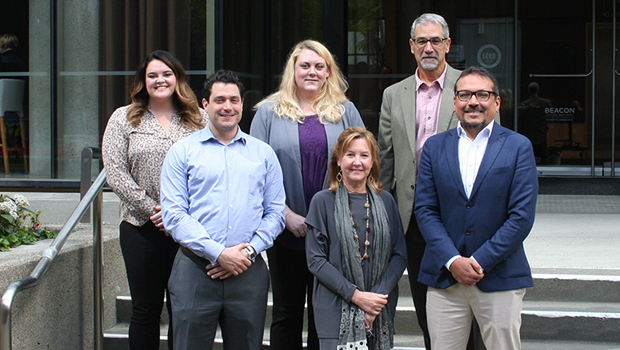Partnering to advance lifesaving care

Clockwise from top left: Amy Lee, James Ralston, Brooks Tiffany, Terry Hannan, Patty Buckley, Ryan Caldeiro, and Joe Glass. Photo by Amy Lee.
Amy Lee describes how the LHS Program is helping KP Washington track and improve treatment for opioid use disorder
By Amy Lee, MPH, research associate at Kaiser Permanente Washington Health Research Institute (KPWHRI) and a partner in Kaiser Permanente Washington’s Learning Health System Program
Opioid use disorder affects more than 2 million people in the United States—taking a toll on health and wellness, and too often leading to opioid overdose and death. The good news is that effective—and potentially lifesaving—medications exist to treat opioid use disorder in primary care: buprenorphine and injectable naltrexone.
Buprenorphine (often called Suboxone, a brand name) works by binding to opioid receptors in the brain, helping alleviate withdrawal symptoms and cravings—and dramatically reducing the risk of overdose in people with opioid use disorder. Unlike naltrexone, which is given via an injection after a sustained period of time not taking opioids, people can start taking buprenorphine almost right away.
Stigma around opioid use disorder is a major barrier to accessing care for many people. But being able to get treatment in primary care helps reduce that stigma—while making effective treatment available to far more people who need it. People also really appreciate being able to get treatment for opioid use disorder in the same place they get their other care, with providers and care teams they know.
For all these reasons, it’s critical to expand treatment for this condition in primary care settings. And thanks to an interdisciplinary team brought together by our Learning Health System Program, Kaiser Permanente Washington has developed 2 new tools to help ensure high-quality treatment for opioid use disorder in primary care.
Addressing opioid use disorder in primary care: New research sparks an idea
The idea for this quality improvement work arose from a federally funded research study and was made possible by a close partnership between clinical leaders and researchers. Here is how it unfolded:
Researchers at KPWHRI had been working to understand how best to implement a high-quality opioid use disorder treatment model into primary care. The PROUD study, a pragmatic trial at Kaiser Permanente Washington (co-led by KPWHRI Senior Investigator Kathy Bradley, MD, MPH) brought together collaborators from across our organization, including Ryan Caldeiro, MD, who leads Kaiser Permanente Washington’s Addiction and Recovery Services, and Joe Glass, PhD, MSW, an associate investigator at KPWHRI with expertise in addictions research.
This partnership on PROUD led to an important realization: Our health system did not have a way to monitor the quality of the care we were offering patients with opioid use disorder. And care teams struggled to keep track of the components of that treatment—they needed tools to make it easier to deliver high-quality care. Like diabetes, hypertension, and other chronic conditions, treatment for opioid use disorder calls for a systems approach. And that led Ryan to a new idea: We should partner to build those tools as a way to continue improving care for our patients with opioid use disorder.
Moving from idea to reality via our Learning Health System Program
Ryan and Joe took the idea to Kaiser Permanente Washington’s Learning Health System (LHS) Program, which brings research and care delivery together to design, implement, and evaluate timely, evidence-based innovations in care. They were able to quickly garner LHS support for conducting stakeholder interviews to understand challenges and best practices in providing buprenorphine treatment. Because of my experience as an addictions researcher and practice facilitator, and knowledge of workflows and building EHR decision support tools, I came on board to lead the project, conduct interviews, rapidly analyze the qualitative data we gathered, and translate those into practical tools.
For our LHS project, we built 2 tools to improve the quality of care: an EHR dashboard and report to help clinicians improve care for individual patients with opioid use disorder, and an administrative metrics dashboard to help clinical leaders ensure treatment quality across our system. To help us understand health system needs and to build these tools, we needed a team with diverse expertise:
- KPWHRI data architect, Roy Pardee, worked with us to define and pull key data from our EHR to design our administrative dashboard.
- Brooks Tiffany, MA, a user experience researcher at KPWHRI, contributed deep knowledge of user-centered design and led our work to develop interview guides, build prototype tools, engage stakeholders in refining them, and conduct rapid qualitative analysis.
- Our talented Epic analysts, Bao-Uyen Nguyen and Terry Hannan, collaborated with our team to turn the final prototypes into functioning dashboards and reports in Epic.
- James Ralston, MD, MPH, a senior investigator at KPWHRI, provided his expertise and guidance in health informatics and EHR builds.
Bringing together an interdisciplinary team helped us ensure the tools we built would be practical and sustainable—and that we could adapt to challenges we faced along the way. Our partners and stakeholders across KPWA, including health plan administrators, clinical administrators, and primary care team members, helped us understand their needs around tracking and improving effective treatment for opioid use disorder in primary care.
One challenge in building the clinical dashboard was the different approaches to opioid use disorder treatment developed by care teams across the system. We built the dashboard to allow for these minor variations while also clarifying standardized workflows. This helps care teams ensure timely access to treatment and track the necessary clinical components for patients with opioid use disorder—things like urine drug screens, mental health and substance use symptoms, and missed appointments.
A missed appointment is a sign that someone may need extra support—and it serves as a good example of the difference having a clinical dashboard can make. With a dashboard in place, care teams can be better informed on patients needing outreach to engage them back into care. It’s a more holistic and patient-centered approach that can help break down the stigma people with opioid use disorder face when they seek treatment. Keeping someone from slipping off the radar and turning back to opioids can also mean the difference between life and death.
Next steps: Moving toward higher-quality opioid use disorder care
COVID-19 hit as we were trying to wrap up development of the clinical dashboard. But rather than requesting that we put our work on hold, leaders at Kaiser Permanente Washington asked us to keep going. So we focused on adapting the dashboard to include virtual visit workflows.
With these adjustments completed, Patty Buckley, an Epic trainer in care delivery, recently created tip sheets to help primary care teams understand and use the dashboard. Patty is currently leading trainings with care teams from 3 primary care clinics to get their feedback. Then she’ll work with Terry to make adjustments as needed and have care teams pilot the tools in real time with patients. After making any additional adjustments, we’ll partner with Annie Chun, MD, Kaiser Permanente Washington’s director of primary care operations, to start developing a large-scale implementation plan.
Our goal is to make high-quality opioid use disorder treatment with buprenorphine readily available to every Kaiser Permanente Washington member who needs it—and I’m hopeful that the dashboards we created through the LHS Program will help us get there. For other chronic conditions like diabetes and hypertension, it’s long been a best practice to track access and quality, and to be proactive and patient-centered in helping people manage their care. People with opioid use disorder deserve no different.


